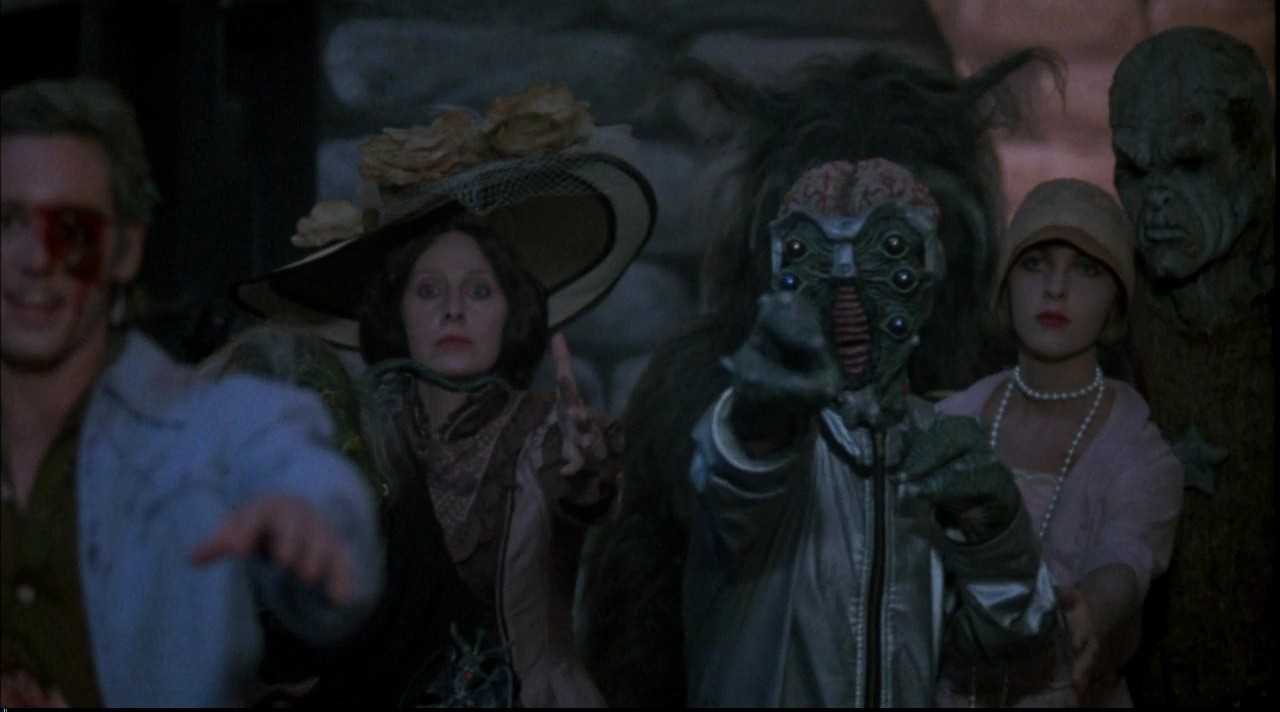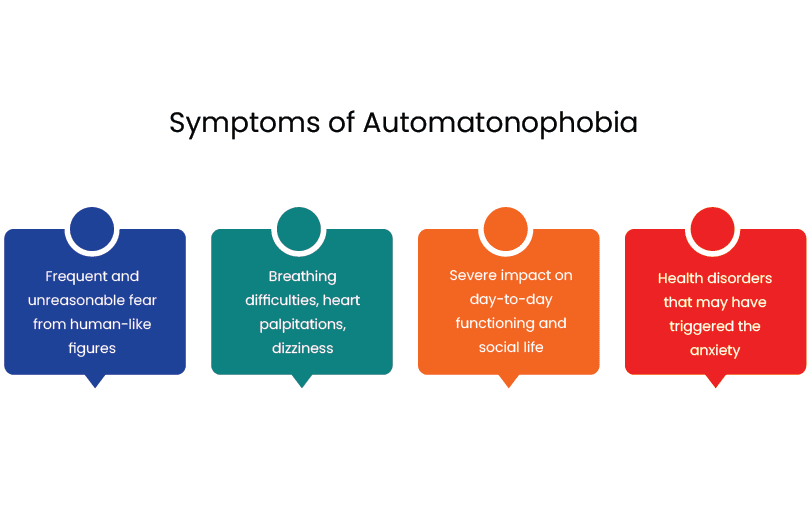Introduction
You must have heard about some prevalent phobias like fear of heights, fear of flying, or fear of getting into the water. However, some phobias are uncommon and hence, can go unnoticed. One such unique phobia is automatonophobia [1], which makes people fear human-like figures, including human dummies, wax figures, statues, robots, or animatronics.
Automatonophobia: Fear of Human Like Figures
Have you ever felt uncomfortable while looking at a human-like figure? Chances are, we all have felt that unease at some point in our lives. However, if this fear or phobia of human-like figures is so extreme that it starts affecting day-to-day life, one must seek professional help from psychologists or therapists [2].
Automatonophobia Statistics
Studies [3] have confirmed that any phobia’s visual impact is much higher than other forms like thinking or reading, making automatonophobia more severe. Automatonophobia may happen due to several reasons, including a traumatic experience, genetic, or environmental. Interestingly, fear of dolls (pediophobia), another phobia, is similar to automatonophobia but not the same.
While automatonophobia can cause excessive panic attacks or irrational behavior upon encountering human-like figures, it is treatable. Mental health professionals use various methods like Cognitive Behavioural Therapy (CBT), exposure therapy, and medication to reduce and cure such phobias.
Automatonophobia Definition: What is Automatonophobia?
Automatonophobia is defined as a specific fear caused by human-like figures, including mannequins, wax figures, dummies, statues, or animatronic creatures. People who have this phobia become uncomfortable and behave irrationally upon seeing human-like figures. The fear of wax figures is intense; even small things such as visiting a wax museum or a shopping mall with mannequins can send down shivers, disrupting the social life of the person suffering from it. The good news is that there are ways to test, evaluate, and treat automatonophobia.
The pronunciation of automatonophobia is as unique and complex as the phobia itself. Try using the phonetics “au-tomatono-pho-bi-a” to say it correctly. Luckily, it is much easier to pronounce than another phobia known as hippopotomonstrosesquippedaliophobia, the longest word in the dictionary that defines the fear of long words. Perhaps the best example to define “irony.”
Let us discuss what triggers the fear of human-like figures.
Causes of Automatonophobia
The causes for automatonophobia primarily fall into two categories: experiential – any traumatic event triggered involving a human-like figure and non-experiential – such as the genetics of a person. So, the reason for phobia can be as apparent as someone who watched a scary movie of mannequins and developed an extreme fear or, like other common anxiety, it may be hardwired in a person’s genes. Below are few common causes:
- Traumatic experience
Any horrible experience involving wax figures or human-like figures such as scary movies or a bad experience involving robots might become a phobia that haunts for a long time. - Genetics
It can simply be in the genes [4] to be more anxious and prone to specific phobia. People who have mental health patients in their family or relations may be more inclined to anxiety disorders and phobias. - Negative thoughts
Our thinking can both create and solve all the problems we face in our life. The phobia may develop subconsciously due to our negative thinking patterns.
Symptoms of Automatonophobia
People who have automatonophobia can have a wide range of mental and physical symptoms. Although, the symptoms may vary depending on the severity and underlying cause of the phobia. However, one definitive symptom is excessive panic attacks and irrational fear of human-like figures. Mental health experts evaluate the symptoms to determine the exact nature of phobia and suggest ways to manage and treat it accordingly:
- Frequent and unreasonable fear from human-like figures.
- Anxiety and panic attack symptoms such as breathing difficulties, heart palpitations, dizziness in the presence of human-like figures, and wax figures.
- The person who has phobia avoids exposure to human-like figures due to irrational fear resulting in a severe impact on day-to-day functioning and social life.
- The phobia has persisted for at least six months, and there are no signs of any other underlying mental health disorders that may have triggered the anxiety.
Read More About The Staggering Statistics Behind Violence Against Children
How to Overcome Automatonophobia: Cure for Fear of Wax Figures
Automatonophobia is unique, but it can be managed and cured by psychologists and mental health experts. In the digital era, you no longer need to visit a therapist for counselling in person; they are easily accessible online. Most therapists use cognitive behaviour therapy [5] (CBT) which challenges the way the patient thinks about fear and learns to manage it by doing activities such as practising mindfulness, meditation, and breathing exercises.
Although it is difficult and may take a long time, patients can overcome the fear of human-like figures by changing their thought patterns gradually:
- Rewire your brain
Regular counselling and CBT techniques can help people suffering from phobias change the way they approach their fears. - Learn to accept setbacks
During the treatment, the patient may have a relapse of panic attacks. However, they should not let it stop them from their goal of getting rid of the phobia. - Develop healthy habits
Our mind and body are interdependent. Physical activities like running, stretching, and yoga are great ways to improve overall well-being.
Explore Our Self-paced Courses
Automatonophobia Treatment: How to Cure the Fear of Human-Like Figures
When you experience frequent panic attacks due to a phobia, the first step is to seek help from mental health experts. Therapists can evaluate your symptoms and begin the treatment using various techniques such as cognitive behaviour therapy, and exposure therapy and might also prescribe anxiety-reducing medications for better results.
Let us look at the most common treatment methods used for curing automatonophobia.
Exposure Therapy for Automatonophobia
Psychologists use exposure therapy to treat the fear of human-like figures. The patient is gradually exposed to the fear in a safe environment to reduce anxiety and improve their quality of life. The use of Virtual Reality (VR) has increased for therapies in recent times, and studies have shown that exposure therapy using virtual reality [6] technology is highly effective. Exposure therapy works well in the treatment of automatonophobia since patients are aware that the threat is not real. Hence, they learn to face their phobia and reduce their irrational anxieties.
Phobia Therapy for Automatonophobia
Our mind is our greatest enemy and our greatest ally when it comes to automatonophobia and its treatment. Cognitive behaviour therapy helps overcome negative and fearful thoughts using various activities and techniques such as learning mindfulness, diverting your attention using breathing exercises, and reacting to fear positively. CBT is a highly effective psychotherapy for automatonophobia. Like most anxieties, fear of human-like figures is ingrained in the patients’ minds, and changing the way they think can improve their conditions significantly and help them lead a better life.
References
[1] L. Fritscher, “Insight Into the Rare Phobia of Wax Figures and Humanoid Robots,” Verywell Mind. [Online]. Available: https://www.verywellmind.com/automatonophobia-2671847. [Accessed: 02-Aug-2022].
[4] M. G. Gottschalk and K. Domschke, “Genetics of generalized anxiety disorder and related traits,” Dialogues Clin. Neurosci., vol. 19, no. 2, pp. 159–168, 2017.[5] A. Galvao-de Almeida et al., “The impacts of cognitive-behavioural therapy on the treatment of phobic disorders measured by functional neuroimaging techniques: a systematic review,” Rev. Bras. Psiquiatr., vol. 35, no. 3, pp. 279–283, 2013.[6]V. Mitrousia and O. Giotakos, “Virtual reality therapy in anxiety disorders,” Psychiatric, vol. 27, no. 4, pp. 276–286, 2016.






